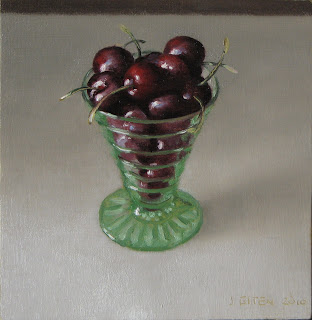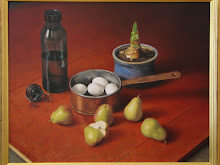Tuesday, December 7, 2010
The process of painting on copper
Here is the start of a painting on copper. I used a 6x8 inch copper etching plate for the painting surface; these can be purchased in most art and supply stores. Copper has been used by painters in the past as a reliable painting surface. It is different from canvas or a wood in that it does not change. It won't stretch or shrink with weather or age. Paintings made by Dutch and Flemish painters back in the 1600's have a remarkable quality to them- as if they had just been painted yesterday. The paint appears to be fresh and rich and does not seem to have dried out. Paintings done on canvas or wood often crack or peel with age.
To prepare the copper plate I used a Pre-Raphaelite medium, although you could use most any kind of medium to prepare the surface.
Three Oranges with Cherries
This is the first stage of the painting. It is what's called the prematura stage of the painting- an initial layer of color. This is different from an underpainting that is painted with greyscale. Adjusting the value (lights and darks) and chroma (color) are all happening at the same time. This does pose extra challenges but they can be remedied in future glazes of paint.
Three Oranges
This painting on copper is about half way done. I have worked into it twice already-the prematura layer and the first glaze. I usually use a couch of Pre-Raphaelite medium or a mixture of stand oil with Gamsol paint thinner; either one will give the paint some body to it.
Orange with Broken Tea Pot
Here is a 6x8 inch painting on copper that is nearing completion. I have three or four glazes of paint on the copper so far.
This is the oil medium that I used on this set of paintings on copper. It is a wonderful medium that is made by Studio Products Inc.
I often use it when I am painting in plein-air or when adding a second or third layer of glaze on a painting in the studio. I use it as a couch for the painting; I spread a thin layer of it on my painting surface with a bristle brush and then paint on top of that. It can be used in preparing copper plates before painting as well.
Thursday, December 2, 2010
Onion Bottle with Apple Blossoms
Here is another painting that I finished last week for a show in Cambridge, MA. The frame is the same style as the frame on the church interior painting. These are float frames that John White from Cape Elizabeth, ME. made for me. This onion bottle is a circa 1600 Dutch bottle. I love the shape and the imperfections in the glass.
Monday, November 22, 2010
Hooglandse Kerk

Here is a painting that I did this Summer. It was a remake of an older painting that I did about 9 years ago. The original painting was very small and it took some time to finish due to the small brushes that I was using. The original did not have figures in it. I found that having the two seated figures suddenly gave scale to the church interior!
This painting was a little larger ( 12x 17 inch framed) thus not taking quite as long to finish. I certainly learned from the mistakes that I had made years before. I also learned that my way of looking at an image had changed as well.
Hooglandse Kerk was done for the specific purpose of having giclee prints made in honor of two church organists where my parents attend.
Tuesday, July 13, 2010
Broken Teapot with Orange

Here is a small work that I recently had done on a copper plate. I prepared the plate by painting several layers of Pre-Raphaelite (Studio Products) oil medium on it and then allowed several days for the surface to dry. The medium has a quite a bit of lead in it which adhears well to the copper and provides a good surface for the oil paint to cling to.
Saturday, July 10, 2010
Thursday, June 17, 2010
Filming of "The Chef's Kitchen"


 A week and a half ago I had the pleasure of showing my work and making an appearance on "The Chef's Kitchen." This is a nationally syndicated cooking show that features world-class chefs with their tips and techniques. If you can't find it in your local listings, you can view episodes on http://www.hulu.com/. The director and my friend, Steven Horn, and his kind and professional staff made me feel completely comfortable in an atmosphere that is obviously different from what I am used to!
A week and a half ago I had the pleasure of showing my work and making an appearance on "The Chef's Kitchen." This is a nationally syndicated cooking show that features world-class chefs with their tips and techniques. If you can't find it in your local listings, you can view episodes on http://www.hulu.com/. The director and my friend, Steven Horn, and his kind and professional staff made me feel completely comfortable in an atmosphere that is obviously different from what I am used to! Many thanks to Bonnie Harrison of Bonnie Harrison Photography (http://www.bharrisonphotography.com/) for the photos and the support.
The next post shows the finished images of two of the paintings I took to the show.
"Copper Bowl with Apples" and "Sea Bass with Leeks"
Wednesday, May 12, 2010
Saturday, April 10, 2010
Tuesday, March 23, 2010
Saturday, March 20, 2010
still life with pan of apples
Wednesday, March 17, 2010
First layer of paint
Wednesday, March 3, 2010
finishing underpainting

I have finished the underpainting for my seabass painting. As you can see, I have applied color to the 24 x 36 inch panel. I have no grayscale underpainting that I am working from. I am working from photographs and the line drawing that I did earlier.
In the plate to the left, I changed the arrangement of the lemons. Instead of two lemons I decided that one peeled lemon might look more interesting. Willem Kalf (a Dutch painter) did a wonderful painting with a lobster and drinking horn. It has a little peeled lemon lying on the table; I have always wanted to do something similar. I thought the peeled lemon might compliment this seafood arrangement.
Tuesday, February 23, 2010

Here is a painting that I just got started on yesterday. I am by-passing the value underpainting where you establish the values first. What I am doing here is certainly a faster way to go but can be more problematic. Not only do I have to concern myself with hitting the right hue and the saturation of the color. I also need to keep in the mind whether the values ( lights and darks) of the color are close to what I am seeing. If not, I will have to do some reworking. I am painting from the background to the foreground of the underpainting.
Wednesday, February 10, 2010

I have started to put in a light glaze of color to the underpainting. I am using a simple method of application called a "couch". I apply a few dabs of thick stand oil in the area I wish to paint and then rub paint thinner into the oil. (I use Gamsol mineral spirits.) This provides a nice slippery surface to work into and dries within a days time. The stand oil helps keep the paint conditioned and slightly fatty so that it won't crack over time. This is only the first layer of paint that I am putting on right now. This gives me an idea how close my colors are at so that I can tweak them later.
Thursday, January 21, 2010

Here are two pictures of an underpainting that I have been working on. The first is an earlier stage of the process (showing the original under drawing in silver point) and the second is nearing the end of it. The value scale ranges between 4-9 (4 being darkest values and 9 being lightest values). I am trying my best at using the golden spiral as a compostion tool. It is a 24X36 inch painting. I don't imagine this one is going to go very quickly but you never know.
Wednesday, January 13, 2010
Plate of Truffles (small work) 11x13 inch
Tuesday, January 5, 2010
Helios
Subscribe to:
Comments (Atom)


























